Mimosa Trees (Albizia Julibrissin): Facts, Flowers, Leaves (Pictures)
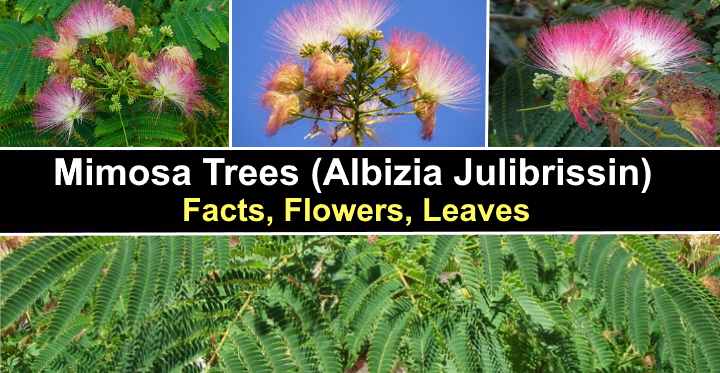
The mimosa tree is a fast-growing ornamental tree with silky white or pink pompom-like fluffy flowers, fern-like leaves, and brown flat, bean-like seed pods. Also called the Persian silk tree, the mimosa tree is easy to care for, tolerates drought, and thrives in the summer heat. However, mimosa trees grow quickly, and the small to medium-sized deciduous trees can become invasive outside their natural habitat.
There is much debate if mimosa trees are desirable, decorative, beautiful trees or a nuisance in the landscape. People who love mimosa silk trees point to their attractive foliage and pink feathery flowers. On the other hand, opponents of Persian silk trees say that their vigorous growth crowds out native shrubs and trees, and their seed pods and leaves cause an unnecessary mess.
However, mimosa trees are not invasive in all areas. The beautiful flowering, heat-loving trees can add color and shade in a garden landscape in the right environment.
This article is a guide to growing the mimosa tree Albizia julibrissin. Descriptions and pictures of mimosa tree bark, leaves, seedpods, and flowers will help identify these attractive trees. You will also find helpful information on growing a Persian silk tree in your front or backyard.
Mimosa Tree (Albizia julibrissin) Facts
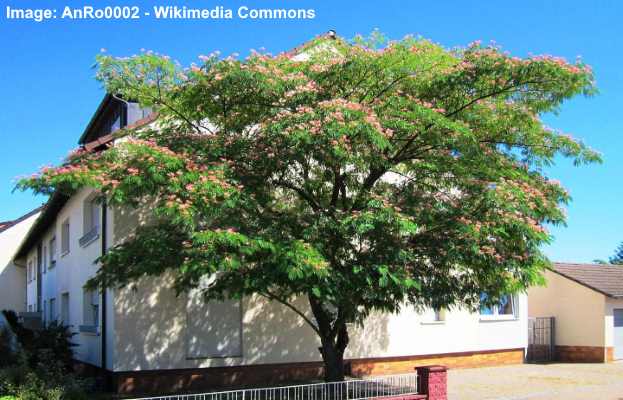
Mimosa tree (Albizia julibrissin) is also known by the names pink silk tree and Persian silk tree
The mimosa tree is a deciduous, medium-sized tree in the genus Albizia and legume family Fabaceae. Mimosa trees have a vase-shaped growth with a spreading, broad crown. A full-grown mimosa tree can measure between 10 and 50 ft. (3 – 15 m) high and up to 50 ft. (15 m) wide.
Mimosa trees are native to Asia and thrive in warm climates in USDA zones 6 through 10. Silk trees have a rapid growth rate, growing around 3 ft. (1 m) per year. However, they are short-lived trees. The average lifespan of mimosa trees is only 30 years. Additionally, the trunk and branches are weak and brittle and easily break in strong winds.
Albizia julibrissin has the common name mimosa due to the resemblance to mimosa plant leaves. Other names for mimosa trees include the Persian silk tree, pink siris, pink silk tree, and Lenkoran acacia.
Mimosa Tree Flower
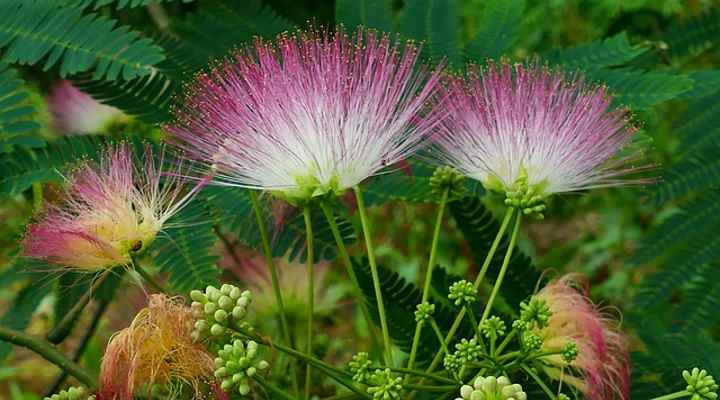
A close up picture of mimosa tree flowers
Mimosa tree flowers are fuzzy balls of silky pink threads that bloom during summer. The thin string-like stamens measure 0.8” to 1.2” (2 – 3 cm) long. Mimosa blossoms can be pink or white, but they always have a white base. The pink fuzzy tree flowers give off a pleasant fragrance.
Mimosa Tree Leaves
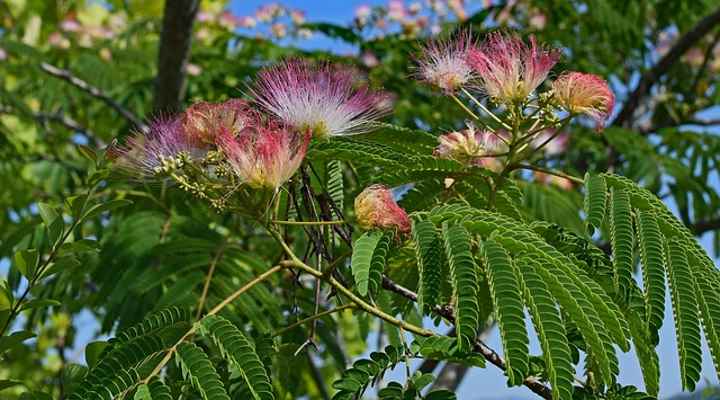
mimosa tree leaves
Mimosa tree leaves are medium green, compound feathery leaves that look like fern leaves. Small leaflets grow on long stems measuring 10” – 20” (25 – 50 cm) long. There can be between 20 and 30 pairs of pinnae on each leaf stem on mature mimosa trees, with 10 to 20 leaflets on each pinna.
An interesting fact about mimosa tree leaves is that fern-like leaflets are very sensitive and close up when touched, at nighttime, or when it rains. In Asian languages, common names refer to this habit of leaves closing at night. For example, some translations for the mimosa tree’s common names include “sleeping tree,” “shut happy,” and “night sleeper.”
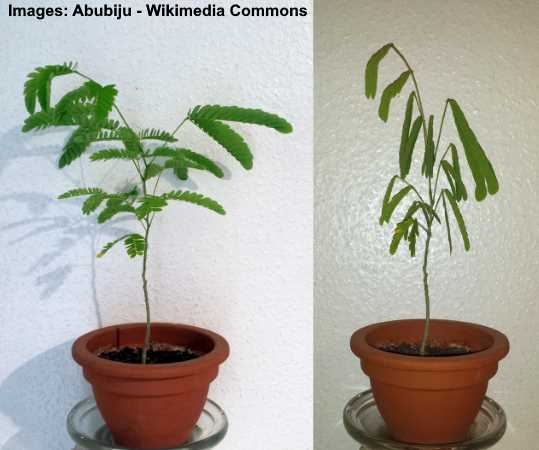
Mimosa tree by day (left) and “sleeping tree” at night (right)
Mimosa Tree Pods

Mimosa tree seed pods
Mimosa trees are a member of the pea or bean family Fabaceae. Mimosa fruit is green when immature and brown when matured. Mature mimosa seed pods are flat, papery, and elongated with 5 to 10 pea-like seeds. Mimosa tree pods measure 4” to 8” (1.2 – 2.4 cm) long and 1” (2.5 cm) wide. The dangling pods appear green in June and turn brown by late summer and early fall when they disperse their seeds.
Mimosa Tree Bark
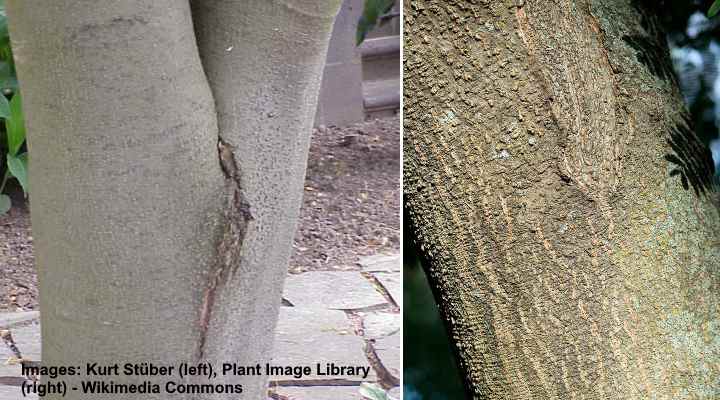
Examples of mimosa tree bark
Mimosa tree bark is smooth and light brown to gray. As the mimosa tree matures, shallow vertical fissures appear on the bark.
Mimosa Tree Identification
The best way to identify mimosa trees is by their pinnately compound leaves and pink puffball flowers. Their fern-like foliage characteristics and elliptical shape identify the large mimosa tree leaves. In addition, Mimosa trees are easily identifiable by their silky pink flowers growing in pompom-like clusters.
Mimosa Tree Growing Issues
The main issue with growing mimosa trees is that they are invasive. Mimosa trees produce abundant seeds that scatter over long distances. Its rapid growth means that in a short time, many mimosa trees are growing, choking out native trees. In some cases, the number of native woodland trees is greatly diminished.
Additionally, a vast number of seed pods can litter the ground where silk trees are growing. This can cause issues for homeowners when trying to clear up fallen leaves and seed pods in the fall. Finally, because the root system is relatively close to the ground, it’s not a good idea to plant trees close to buildings.
One thing to consider before planting a mimosa tree in your garden is its brittleness. Branches tend to snap easily in high winds. The exposed bare wood also makes mimosa trees susceptible to another common problem—mimosa wilt. Fungal infections can affect its growth and eventually kill the tree.
How to Control or Remove Mimosa Tree
Persian silk trees are challenging to control. Mimosas tend to re-sprout even when you cut the trees to a stump to try and get rid of the noxious trees. Therefore, it’s best to cut down a mimosa tree before it seeds. This prevents further problems with trees growing.
Even if you cut the mimosa tree to a stump, you’ll have to treat it to prevent it from re-sprouting. One easy way to remove a mimosa tree for good is to use salt. Salt has a toxic effect on plants and can be used to kill mimosa tree stumps.
To kill a mimosa tree stump with salt, you need rock salt, a drill, and a tarp. Drill large holes into the stumps and visible roots. Then, fill the holes with rock salt and lightly water the tree roots. After that, cover the tree’s roots and stump with the tarp to prevent rain from rinsing the salt away. Repeat every few weeks to stop the mimosa tree from returning.
Instead of rock salt, you could use Epsom salt to kill off the remaining part of the silk tree.
What is Chocolate Mimosa Tree (Albizia julibrissin ‘Summer Chocolate’)
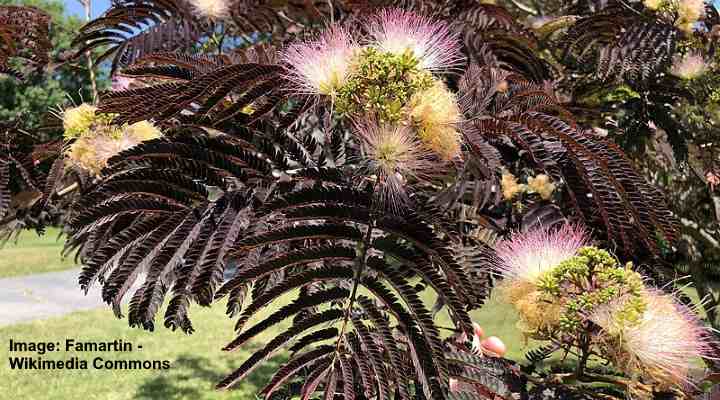
Chocolate mimosa tree (Albizia julibrissin ‘Summer Chocolate’) is not as invasive as other varieties
The chocolate mimosa tree is a small deciduous tree with chocolate-burgundy foliage. The dark-colored tree has a vase-shaped habit with a spreading umbrella crown. Pinnate deep burgundy leaves and pink fuzzy flowers help to identify the chocolate mimosa tree. Chocolate mimosa trees grow between 15 and 20 ft. (4.5 – 6 m) tall and up to 20 ft. (6 m) wide.
One reason to plant a chocolate mimosa tree in your yard is that it’s not as invasive as other varieties. The dark foliage tree produces fewer seeds and it isn’t such a concern as the other species of mimosa tree. Chocolate mimosa trees are suitable for USDA zones 7 to 9.
Chocolate mimosa tree flowers
Flowers on the chocolate mimosa silk tree are fragrant fuzzy, pink powder-puff flowers with white base that bloom during summer. The spindly, pink flower clusters of threads cover the tree. The beautiful feathery flowers attract pollinators and are attractive to look at. Mimosa flowers measure 1” to 2” (2.5 – 5 cm) long.
Chocolate mimosa tree leaves
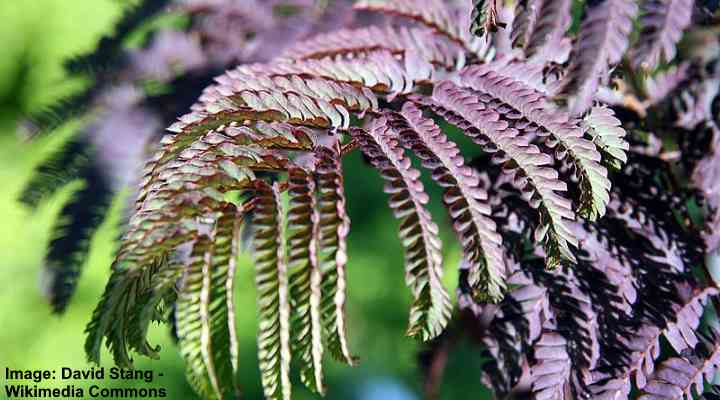
Chocolate mimosa leaves
The spectacular fern-like leaves emerge green and turn deep burgundy to purple through summer until fall. The chocolatey-colored deciduous leaves give the tree an eye-catching unique look. The dark foliage persists on trees and drops in the fall without changing color.
Growing in Mimosa Trees in Pots
Mimosa trees grow well in containers and are excellent patio, deck, or balcony plants. If you live in colder climates, you can keep a mimosa tree in a pot indoors in the winter and move it to the garden in summer. Indoors, keep the potted mimosa in a cool spot away from direct sunlight.
Mimosa is a low-maintenance plant when growing in a pot. You need to grow the tree in a loamy potting mix and only water when the soil has partially dried. Although mimosa trees can grow up to 50 ft. (15 m), keeping them in a large container and pruning will limit their height.
Planting Mimosa Tree in Gardens
If you decide to plant a mimosa tree in your yard, it’s wise to choose the correct location. Mimosas have shallow roots that only grow 2 feet (60 cm) deep. Therefore, don’t plant it within 10 to 20 feet (3 – 6 m) of a building or sidewalk as the roots can affect the structural integrity.
It’s also a good idea to keep the messy tree away from driveways, patios, lawns, or other garden areas you want to keep clean.
Growing Mimosa Tree (Albizia julibrissin) — Mimosa Tree Care Guide
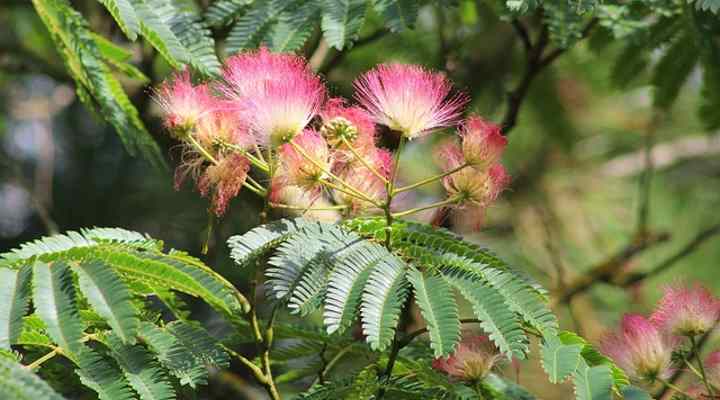
Mimosa trees are low-maintenance and fast growers
Let’s look in detail at how to grow a mimosa tree in your garden. Because silk trees are fast growers, they need little care in a landscape to grow well.
Where to Plant Mimosa Tree
Plant a mimosa tree in the sunniest spot in your front or backyard. Mimosa flowers are most spectacular when growing in full sun with at least six hours of sunlight daily. In arid regions, some afternoon shade is acceptable for healthy growth.
The ground where you plant a mimosa tree should be acidic—a pH level between 4.6 and 5.0 is ideal. However, mimosa trees tolerate a range of soil conditions and will grow in alkaline or poor soils.
How to Water Mimosa Tree
Water the mimosa tree enough so that it gets 1” (2.5 cm) of water a week. If there is heavy rainfall, then you’ll not need to water the tree. However, during long, dry spells, watering once a week should keep the tree growing rapidly.
Silk trees are relatively drought-tolerant plants. This means that they will withstand short periods of arid weather without much problem. However, if you have severe droughts, then an irrigation system can help provide enough moisture for the tree.
Mimosa Tree Growing Zone, Temperature, and Humidity
Mimosa trees thrive in USDA zones 6 to 10 and enjoy warm, sunny conditions. The ideal temperature range for silk trees is between 65°F and 75°F (18°C – 24°C). However, as a subtropical tree species, mimosa is sensitive to extremely cold temperatures.
Mimosa trees thrive in humid conditions. However, as long as the temperature is warm and doesn’t dip below freezing, the tree should grow well.
Because of their adaptability and tolerance for humidity, mimosa trees are common in Florida, South Carolina, Texas, and other southern states.
How to Fertilize Mimosa Tree
Applying a balanced tree fertilizer in spring can help prevent growing issues with mimosa wilt. Usually, a slow-release, granular tree fertilizer with an NPK rating of 10-10-10 encourages new growth and prolific blooming. Or you can apply a diluted water-soluble fertilizer every six weeks in the growing season to promote good tree health.
Alternatively, you can leave the fallen leaves on the root area to break down and provide organic fertilization.
Pruning Mimosa Tree
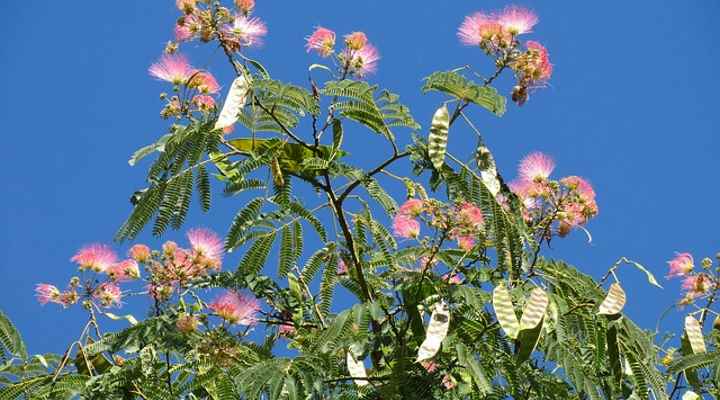
Mimosa tree pruning is important to remove weak or broken branches
Pruning a mimosa tree is vital to keep the tree looking beautiful and remove weak, decaying, or dead branches. The best time to do some heavy pruning is in winter, when growth is dormant. However, you can lightly prune mimosa trees at any time of the year.
Regular pruning helps to keep the long, drooping branches looking attractive. In addition, due to the brittle branches, pruning is essential to cut off broken branches and encourage vigorous growth.
How to Propagate Mimosa Tree
Propagating mimosa trees is best done by rooting branches or germinating seeds.
To propagate a mimosa tree from a branch, cut a 4” to 6” (10 – 15 cm) of a non-blooming stem in late spring. Then, remove all the lower leaves apart from the few top ones. Next, dampen the cut end, dip in rooting hormone, and place in a pot containing moist potting soil. Seal in a plastic bag and keep in a bright spot at least 75°F (24°C).
After a few weeks, when the plant has rooted, transfer the baby mimosa tree to a larger container. Finally, after a year, the tropical tree is ready to be replanted outdoors.
If you have dried mimosa seeds, you can germinate them by putting them in warm water and allowing them to soak overnight. Next, place the seeds about 1” (2.5 cm) deep in light, moist potting soil. Place in a bright, warm location until the seeds germinate. You can then transfer them to a larger container to continue growing them.
Transplanting Mimosa Trees
The best time to transplant mimosa tree saplings is in spring or fall. However, if you are transplanting an established silk tree, dig up the tree in late fall for transplanting. But if you live in the cooler areas of the tree’s growing range, only transplant the tree in early spring to avoid stressing the roots.
Pests and Diseases Affecting Mimosa Tree Growth
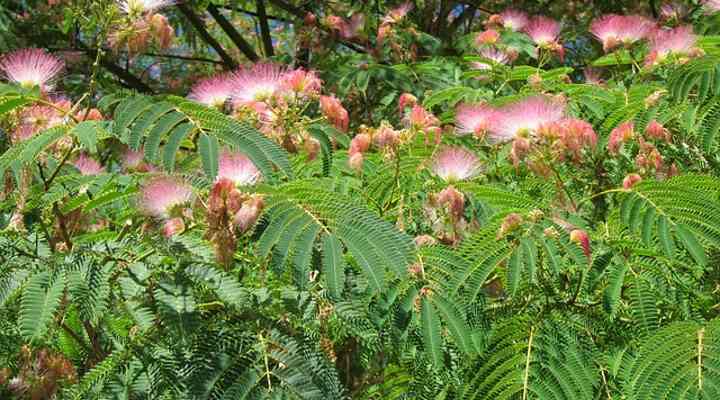
Common pests affecting mimosa trees are mimosa webworms, spider mites, and cottony cushion scale.
Webworms are identified by the webs they spin around leaves. The best way to get rid of them is by removing the ends of infected branches.
Spider mites also spin webs and feed on tree sap; however, the tiny pests are difficult to spot. Introducing beneficial insects such as Stethorus beetles can help keep spider mites at bay.
Cottony cushion scale insects look like tiny pieces of cotton wool. The scale insects feed on foliage and can defoliate and even kill a healthy mimosa tree if the infestation is extensive. You’ll also notice a black, sticky substance on the tree if there are white scale insects.
Mimosa wilt is a disease that causes yellowing leaves and mimosa tree die-back. This fungus infection develops from the roots or via broken branches. The best way to prevent mimosa wilt and reduce its effect is to fertilize the tree during the growing season regularly. However, mimosa trees with wilt usually must be cut down and destroyed.
Common Care Issues Growing Mimosa Tree
The most common reason mimosa trees die is wilt caused by the soilborne fungus Fusarium oxysporum f. sp. Perniciosum. Mimosa trees growing in poor soil are especially susceptible to wilt. Therefore, it’s vital to care for a mimosa tree to ensure healthy growth.
Over-watering a mimosa tree can also cause growth issues. The trees prefer well-drained soil, and providing too much water can stress the roots. Also, under-watering can be just as bad. Problems with soil moisture expose the roots to fungal infections, which can damage the roots and trees.
Related articles:
